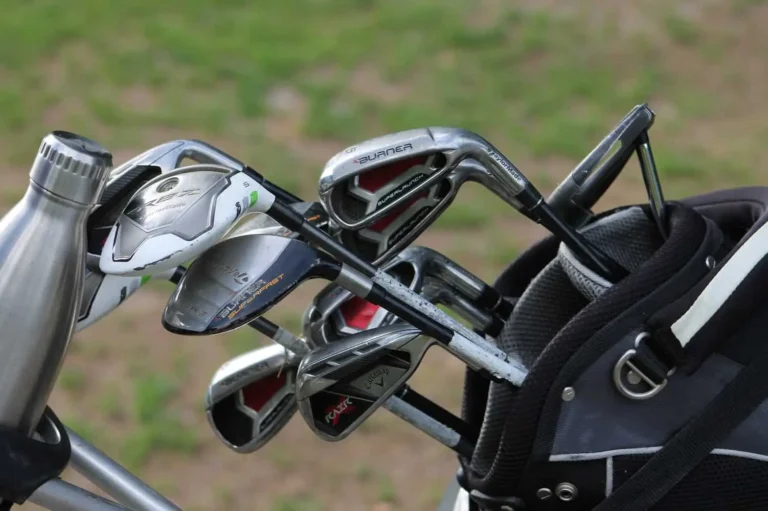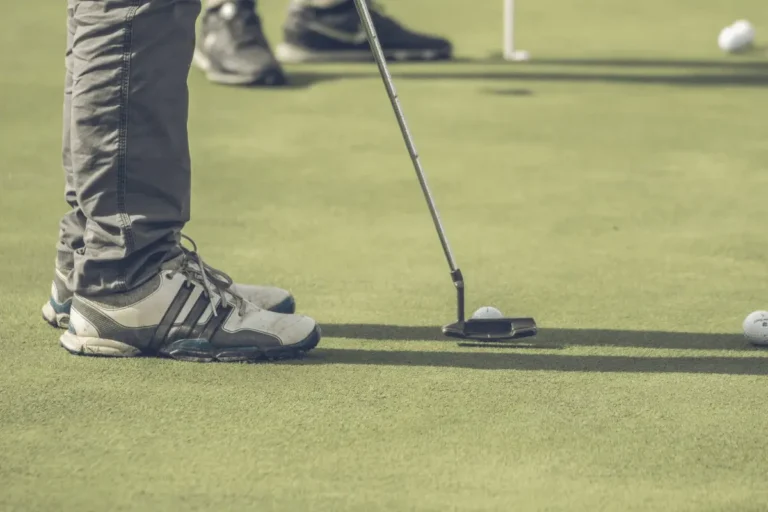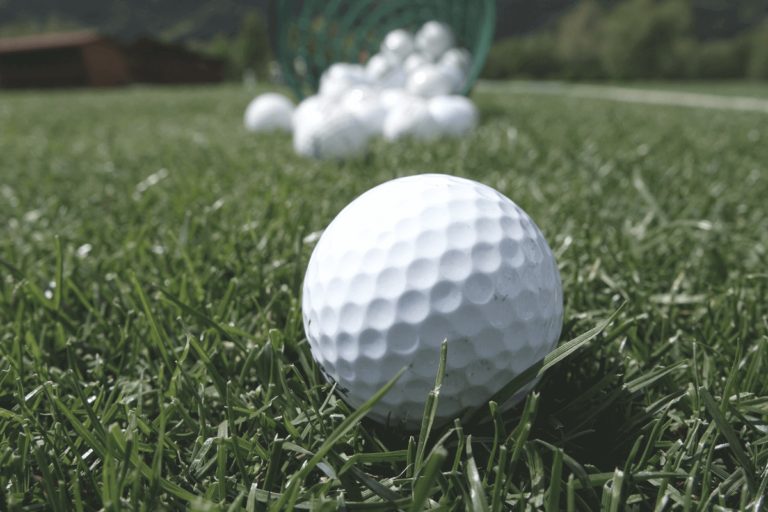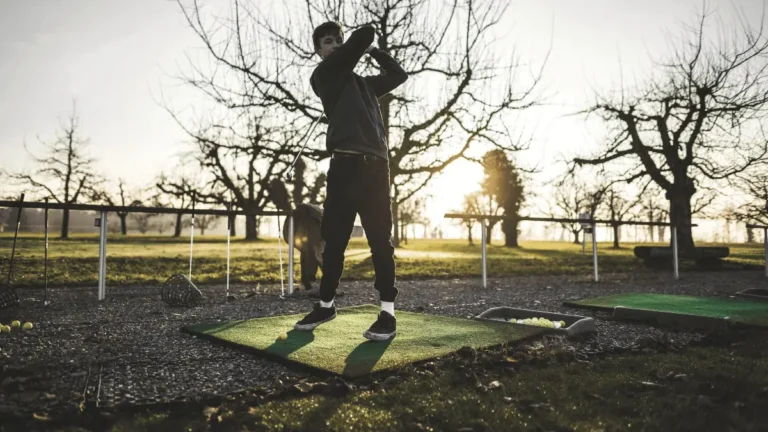How To Hit And Swing A Driver Without injuring yourself
For many golfers, learning to hit and swing a driver is a daunting prospect. Given that the driver is the longest club in any golfer’s arsenal, you want to make sure you’re using it properly. And in a way that will get you greatest impact with smallest strains or injuries like golfer’s elbow.
With proper technique and practice, hitting a driver doesn’t have to be as scary as you think.
Keep reading to discover:
- The fundamentals of hitting a driver
- How to hit and swing a driver
- Golf driving tips and best practices
- How to prevent golfer’s elbow
The Fundamentals of Hitting a Driver
Practice is the only way to Get the perfect shot with your driver, but remembering these fundamental tips will help you get there faster.
Balance is Key
Maintaining your balance is the single most important factor when hitting a driver. Remember to keep your center of gravity near the middle of your stance as you swing up. Then, shift it toward your target as you swing down.
You might be tempted to let your weight shift to your back foot as you swing back, but you’ll get better results if you keep it centered and use that momentum for your downward swing.
Take Time to Complete the Arc
Golf is not a sport you need to rush. The ball will wait for you, so it’s worth taking the time to set up your shot and focus on your swing. Many new golfers try to rush their first driver swings, but the best thing to do is take your time, particularly on your backswing.
Focus on the movement and make sure you take your club right to the top. You can even pause there for a moment before bringing it down. When you allow this full range of movement, you lock in the full power behind your swing. If you cut your backswing short, you risk losing power and your ball won’t go as far.
Use a Sweeping Motion
Unlike iron clubs, you don’t need to hit at a downward angle when using a driver. This would cause too much backspin, leaving you with a weak shot that doesn’t travel far. Using a sweeping motion to hit the ball will give you enough backspin to get the ball in the air without creating a weak shot.
Use Less Effort for Optimal Results
This may seem counterintuitive because you want to hit the ball as far as possible, after all. But swinging your driver too hard may be detrimental if you lose your balance.
Putting less than 100-percent effort behind your swing means you can maintain your balance while still creating enough force to achieve a good distance. This also reduces the likelihood of common injuries including the dreaded golfer’s elbow.
Remember, you want to stay within your limits and not overdo it for the sake of a shot. By focusing on balance rather than speed or force, you can build your strength and increase your distance and control naturally over time.
Pick a Target to Focus On
The key to long-distance shots is preparation and focus. There’s no point perfecting your posture or swinging with force if you don’t know where you’re aiming. That said, many amateur golfers find it difficult to know where to aim when they can’t see the hole.
For this reason, it’s important to pick a specific target in the distance to focus your aim. Your target can be a tree, a bunker, or anything. make sure it’s specific.
Once you’ve found your target, focus your attention there as you line up and take your shot. You’ll be hitting aimed balls in no time.
How to Hit a Driver
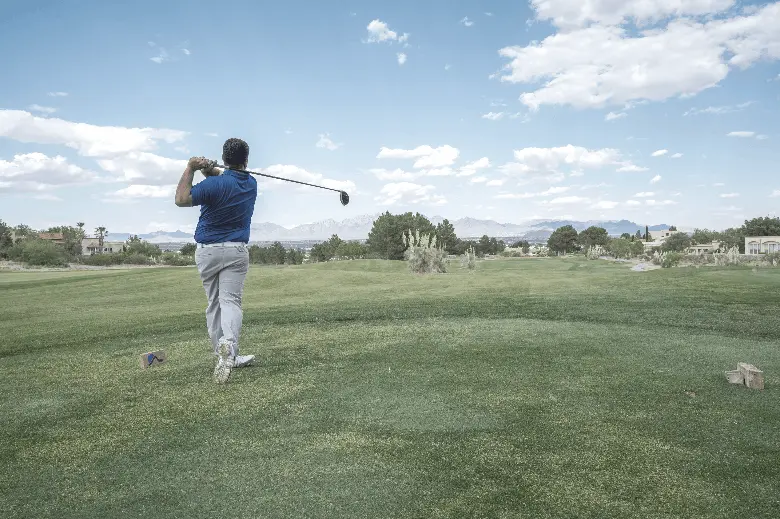
Golfing is all about position. If you spend a bit of time perfecting your posture and hand placement, you will set yourself up for success. Improper posture and technique can lead to injuries such as golfer’s elbow, so it’s important you take your time and don’t rush things.
To begin, stand with your feet wider than your shoulders and center your balance. Given the length of a driver, you should adopt a wide stance so you have ample room for a wide swing.
Use a high tee of 2.75 inches and align the ball with the inside of your dominant foot. When you’re happy with your positioning and feel well-balanced, it’s time for the fun part.
Grip your club as you would a baseball bat, keeping your dominant hand in front. The handle end of your driver should be about 10 to 12 inches away from where you a belt buckle sits on your body. Adjust your positioning if it’s too close or too far.
The best way to get the ball traveling in your desired direction is to select a target in the distance. This is what you’ll be aiming at. Focus on your backswing, making sure you take your time and keep your balance centered.
On the downswing, sweep the club down while shifting your balance to your front foot. Maintain your arm speed even after you hit the ball and complete the swing’s follow-through. Your driver’s head should end up over your shoulder.
How to Swing a Driver
The fundamentals of swinging a driver are much the same as hitting a driver, with a few more aspects to keep in mind. While hitting engages the whole body and focuses on angles, swinging is more about moving the player’s arms to generate speed.
Position yourself with your legs apart and your knees slightly bent. Stand about three steps behind the ball with your weaker hand closer to your chosen target. Your front heel should be in line with the ball. This helps you position your head in the correct place behind the ball.
When swinging a driver, try to place your weight more on your back leg rather than centering it as you do when hitting.
Grip the driver with one hand below the other and just above the head. For right-handed golfers, your left shoulder should be a bit higher than your right shoulder. If you’re left-handed, simply reverse this.
Start swinging back, rotating your upper body starting with your shoulders and shifting your weight to your back foot as you go. Sweep the driver right back until the clubhead is over your shoulders and facing the target you selected earlier.
On the downswing, shift your weight to your front foot and use your lower body to power the shot. As you strike the ball, push your feet into the ground and lift and turn your rear foot. Make sure you raise your foot after you’ve hit the ball, not before, as this helps the ball travel in a straight line.
Keep swinging after you’ve hit the ball, bringing your club over your front shoulder. Ideally, you should point your shoulders to the left of your target when you’ve completed your swing if you’re right-handed.
Golf Driving Tips and Best Practices
Many golfers struggle to perfect their driver swing so don’t worry if you don’t get it on your first try. Chances are, even the pros had the same problem at some stage in their career.
Below are some common problems golfers face when learning to hit or swing a driver, as well as some tried-and-true solutions to those problems.
Nerves and Pressure
Often, the biggest barrier for golfers learning to hit or swing a driver is nerves. Feeling tense at the tee can affect a golfer’s stance and grip, resulting in rigid movements and quicker, shorter backswings.
If you feel pressure when attempting this swing—either from yourself or your peers—try to focus on making your movements as smooth and focused as possible.
One way to achieve this is by positioning your lead shoulder behind the ball. Doing so means you’ll get the full rotation you need to send the ball soaring.
Another method is to spend a few moments wiggling your fingers and toes to help loosen any tension you’re carrying. When you’re relaxed, your swing is much smoother.
Slices
Hitting a slice—where the ball curves mid-flight—is a common issue many golfers face. Slices usually occur when players force their right shoulders out and towards the ball during the downswing, creating a steep swing.
Combat this by keeping your right shoulder back and letting the club drop to the inside as you swing down. Keep your back facing your target for longer during the downswing.
Then, once you’ve made a full turn, keep your right shoulder passive to prevent your upper body from spinning out. As the club drops to the inside, swing out to the ball and let your arms release and square the clubface.
Remember to keep your shoulders, hips, knees, and feet parallel to your target line. This straightens your swing. Make sure you aren’t standing too far back from the ball either, you don’t want to open your shoulders too wide and limit how far back you can turn.
If you have a logo on your shirt, a good trick is to position that logo in line with the ball. This allows you to keep your shoulders square and affords you enough shoulder and turn space.
Having enough space to turn is crucial when hitting or swinging a driver. Most slices occur when the golfer slows their swing through the hitting area, causing the club to flip over and snap the face closed, which sends the ball veering off-center.
Make sure you keep turning your body towards your chosen target for the duration of the swing. This will stop the club from flipping and, in turn, prevent slicing.
Hitting the Ball Everywhere
The key to precise, targeted swings is consistent arm speed and complete follow-throughs. Too often players slow their speed as they near the ball or after they’ve hit it. This results in a poor shot or a player missing the ball altogether.
When your arms swing at the same speed during the entire arc, you create a nice, smooth flow, which results in a better shot on impact. Remember, hitting a driver is all about finding your rhythm—trying to force the shot won’t work here.
At address, check how far from the ball you’re standing by dropping your right hand off the club and letting it hang. If you can move it straight back to the grip without having to reach, you’re at the right distance. If you feel like you’re reaching, try moving closer to the ball.
Fitness for hitting and swinging a driver well

Maintaining a good level of fitness is important for building strength and flexibility. As an added bonus, it prevents injuries such as golfer’s elbow.
Focus on building your core strength to prevent back strain and reduce overuse of your arms and wrists. When you hit a driver, you use a lot of core muscles as you twist your body. This is where the power you need to hit the ball farther comes from, so it’s important to keep your core strong.
Make sure you’re strengthening your arm and wrist muscles to prevent injury, even during the off-season. These are the muscles that are heavily taxed in golf, putting them at greater risk of injury or strain.
You should also work on your flexibility, particularly in your feet, ankles, hips, and spine. Being flexible and supple improves the power of your swing and how far the ball travels.
Establish a stretching routine. It’s a great way to improve your flexibility over time. Don’t worry if you feel stiff at first, the more you practice, the easier stretches become.
Start with these exercises for five minutes every morning and build your routine as you become more flexible:
- Touch your toes—you can do this standing or sitting but try to keep your back and legs as straight as possible
- Rotate your shoulders. Aim for as close as possible to 90 degrees
- Do a deep squat or three
Practice With a Lighter Club
Using a driver is about speed and precision. To get your ball soaring further, learn how to swing your club fast with efficiency.
One easy way of doing this is by practicing with a lighter club or an alignment stick. Adopt your usual golfing stance and swing your club or stick five times as fast as you can. You want to create a “whoosh” sound after impact. When you hear this you know you’ve hit the sweet spot.
This is a great way to practice your swing and build your strength and endurance so you don’t hurt yourself further down the track.
Use a Higher Loft
The distance a ball travels depends on a few things: the length of the club, the swing speed of the player, and the clubface’s degree of loft. The best way to launch a ball is with a high loft and low spin.
Drivers have a long shaft and low loft, usually between 9 and 13 degrees. This may make accurate hits tricky. If you’re a beginner, try a driver with a higher loft while you practice. Then, when you’re more advanced, you can use a loft of 9.5 degrees or less, but even the pros usually get better results with a lower loft.
Many modern drivers have adjustable club faces so you can experiment with different loft degrees and find what works for you. Using a higher loft may be what you need to get your ball traveling further.
Width is Power

To ensure you have enough room and are well-balanced, establish your space before you start swinging. Since the driver is the longest club in any golf bag, it has the greatest swing arc. This means you’ll be swinging it faster than your other clubs and feeling stable on your feet is key to the speed you need.
Make sure your stance is wide enough so you can swing the club in a full arc while maintaining your center of gravity. A good rule of thumb is to keep your feet parallel with your shoulders at address.
Learn to Swing With Both Hands
Learning to swing with your non-dominant hand is a great way to boost your golfing game. If you can swing with both hands, you will reduce the burden on your body, skirt the perils of golfer’s elbow, and achieve a greater range of flexibility. In short, swinging both ways prevents strains and injuries.
Train your off-side through practice. You don’t have to be swinging like the pros on either side to notice the effects. Even if you’re swinging a light club at the same pace on both sides, it will improve your flexibility and strength over time.
The Takeaway
Learning to hit or swing a driver doesn’t have to be scary. If you take the time to study the fundamentals, practice your technique, and build up your strength and muscles, you decrease your chances of injuries such as golfer’s elbow. Of course, your game will get better with every shot you make too!
Remember, golf is a game of endurance, not brute force so don’t be afraid to take your time getting the perfect shot.



